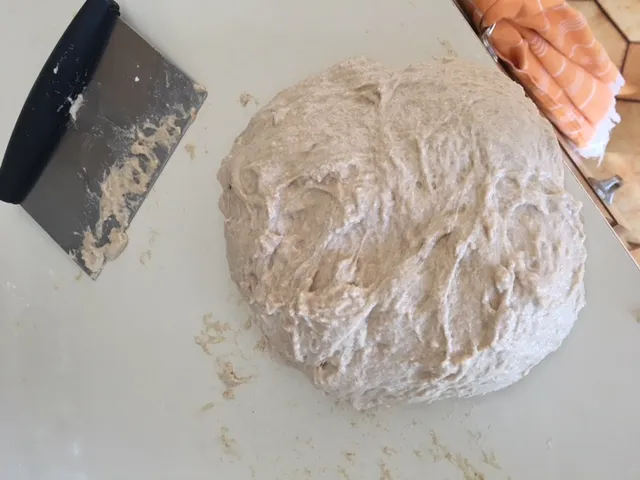
I'm trying to learn how to make high hydration and low yeast breads from Flour Water Salt Yeast.
I made the poolish last night and finished the bulk fermentation this morning (for 2 hours @ 74F). The final dough had 75% hydration with white whole wheat flour.
I was unable to shape the dough because it was really wet and sticky. I've included a picture for reference, which shows 3 folds during the BF and about 3 attempted shapings.
1) Did I do anything wrong?
2) How could I have proceeded in shaping/salvaging the dough?
Thanks,
Bryan
and what flour are you using?
There looks like no structure to the dough. Your final shape has no skin. It could be...
1. Over fermentation (74°F is quite warm and will speed things up)
2. Too hydrated for the flour you are using (if the flour is weak then 75% hydrated might be too much for it)
3. Not enough gluten formation (vital for the structure of the dough)
That's great info. Thanks, Lechem.
I used King Arthur's Organic White Whole Wheat Flour. It says 4g protein per 30g serving on the bag or 13.3% protein. It's the first time I tried using it.
That should be fine. It's high hydration but should be ok if handled well.
So now we're down too gluten formation and fermentation. Perhaps shaping too.
Gluten formation is easier to judge. It's done when it bounces straight back up when poked. Other signs are passing a window pane test (look up on how to do this), the skin of the dough looks 'veiny', has structure etc.
74f is warm so things move quickly. Watch out for that. Dough should be aerated and billowy. Should also have extensibility. Once it shows signs of this then the bulk ferment is done.
Watch videos on YouTube for shaping. A pre shape always helps too.
Piggybacking onto Lechem's note about bulk fermentation - many newer home bakers make the mistake of misinterpreting the instruction i.e. "allow the dough to double during b.f." - or whatever the b.f. instruction is.
The mistake is that while the author is looking for a doubling of volume, a baker may be looking for a doubling of height in the mixing vessel. So when dough is rising in a typical bowl, it may double in volume when it only looks to be 1.5 time the original height.
Not stating that this is your specific problem, but something to be aware of.
How (and for how long) did you mix the dough, once all the ingredients were in it and before bulk fermentation and stretch & fold? You need to work it somehow for about 10 minutes in order to get it close to the strong, silky & stretchy stage before letting it rest, and then you can finish the development with a few stretch & folds.
Also, did you remember the salt? If not, you wouldn't be the first person to do this. :)
Hi Lazy Loafer,
I was trying to stick to the book and followed his instructions to mix using the pincer and fold method, starting these techniques once the ingredients were fully integrated. I then did several folds three times during the first hour of BF.
OHHHH... I'm reading these instructions again, which I halved. There's a good chance I forgot to half the water to be added to the flour, poolish, salt, and yeast. In which case it would have been 100% hydration.
Also note that the poolish was out at 74F for 12 hours too.
Yes, I can see that 100% hydration dough would be hard to handle! Also, check out this link on The Weekend Bakery. They have some very good, simply-explained information about pre-ferments including poolishes:
75% hydration can be handled reliably. During bulk ferment, I wet the work surface so there is a visible film of liquid water on it. Scrape the dough onto the work surface. With wet (dripping) hands, proceed with stretch and folds. The dough will not stick to work surface or hands. If it begins to stick, re-wet hands. A bench scraper, also wet, may help. I frequently do not use a bench scraper. The important point is the work surface and hands must be wet. Not damp or moist.
For final shaping, the opposite of wet is needed. I use a fair amount of bench flour, a few mm thick on the surface. Scrape the dough onto the heavily floured surface, sprinkle the top of the dough with some flour, and thoroughly flour your hands. The shaping is hard to describe in words and I will leave this to others. The important point is that bench flour is a necessary ingredient to this process. The amount of flour, and the shaping technique to develop a taut skin prior proofing depends on the ingredients and formula.
Important points:
- Stretch and fold: wet hands and work surface
- Shaping: dry hands and work surface; bench flour is needed